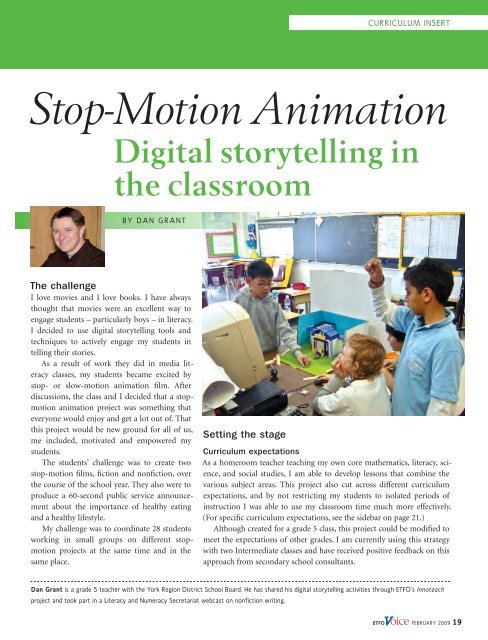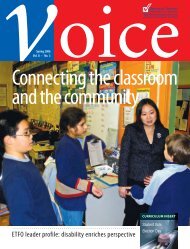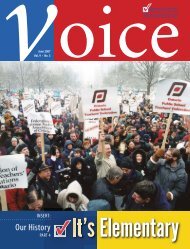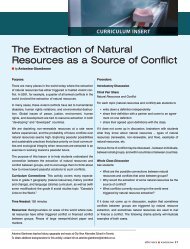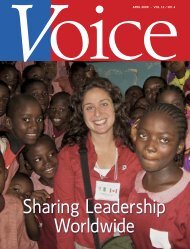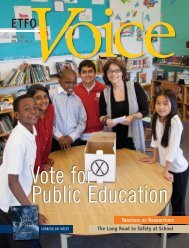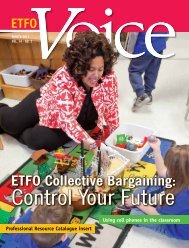Stop-Motion Animation - Digital Storytelling in the Classroom.pdf
Stop-Motion Animation - Digital Storytelling in the Classroom.pdf
Stop-Motion Animation - Digital Storytelling in the Classroom.pdf
Create successful ePaper yourself
Turn your PDF publications into a flip-book with our unique Google optimized e-Paper software.
curriculum <strong>in</strong>sert<br />
<strong>Stop</strong>-<strong>Motion</strong> <strong>Animation</strong><br />
<strong>Digital</strong> storytell<strong>in</strong>g <strong>in</strong><br />
<strong>the</strong> classroom<br />
By Dan Grant<br />
The challenge<br />
I love movies and I love books. I have always<br />
thought that movies were an excellent way to<br />
engage students – particularly boys – <strong>in</strong> literacy.<br />
I decided to use digital storytell<strong>in</strong>g tools and<br />
techniques to actively engage my students <strong>in</strong><br />
tell<strong>in</strong>g <strong>the</strong>ir stories.<br />
As a result of work <strong>the</strong>y did <strong>in</strong> media literacy<br />
classes, my students became excited by<br />
stop- or slow-motion animation film. After<br />
discussions, <strong>the</strong> class and I decided that a stopmotion<br />
animation project was someth<strong>in</strong>g that<br />
everyone would enjoy and get a lot out of. That<br />
this project would be new ground for all of us,<br />
me <strong>in</strong>cluded, motivated and empowered my<br />
students.<br />
The students’ challenge was to create two<br />
stop-motion films, fiction and nonfiction, over<br />
<strong>the</strong> course of <strong>the</strong> school year. They also were to<br />
produce a 60-second public service announcement<br />
about <strong>the</strong> importance of healthy eat<strong>in</strong>g<br />
and a healthy lifestyle.<br />
My challenge was to coord<strong>in</strong>ate 28 students<br />
work<strong>in</strong>g <strong>in</strong> small groups on different stopmotion<br />
projects at <strong>the</strong> same time and <strong>in</strong> <strong>the</strong><br />
same place.<br />
Sett<strong>in</strong>g <strong>the</strong> stage<br />
Curriculum expectations<br />
As a homeroom teacher teach<strong>in</strong>g my own core ma<strong>the</strong>matics, literacy, science,<br />
and social studies, I am able to develop lessons that comb<strong>in</strong>e <strong>the</strong><br />
various subject areas. This project also cut across different curriculum<br />
expectations, and by not restrict<strong>in</strong>g my students to isolated periods of<br />
<strong>in</strong>struction I was able to use my classroom time much more effectively.<br />
(For specific curriculum expectations, see <strong>the</strong> sidebar on page 21.)<br />
Although created for a grade 5 class, this project could be modified to<br />
meet <strong>the</strong> expectations of o<strong>the</strong>r grades. I am currently us<strong>in</strong>g this strategy<br />
with two Intermediate classes and have received positive feedback on this<br />
approach from secondary school consultants.<br />
Dan Grant is a grade 5 teacher with <strong>the</strong> York Region District School Board. He has shared his digital storytell<strong>in</strong>g activities through ETFO’s Innoteach<br />
project and took part <strong>in</strong> a Literacy and Numeracy Secretariat webcast on nonfiction writ<strong>in</strong>g.<br />
etfo FEBRUARY 2009 19
Lesson sequence<br />
1. Develop<strong>in</strong>g media literacy skills<br />
Before we began, we spent a fair bit of time exam<strong>in</strong><strong>in</strong>g <strong>the</strong><br />
language and techniques of film. We also identified <strong>the</strong> three<br />
stages of creat<strong>in</strong>g a film: preproduction, production, and<br />
postproduction.<br />
Initially, students estimated that 20 percent of <strong>the</strong>ir time<br />
would be spent <strong>in</strong> preproduction activities, 60 percent <strong>in</strong><br />
production, and 20 percent <strong>in</strong> postproduction. When <strong>the</strong>y<br />
were f<strong>in</strong>ished, <strong>the</strong>y revised <strong>the</strong>ir assessment: preproduction<br />
took up 75 percent, production 10 percent, and postproduction<br />
15 percent, which shows that students underwent a<br />
substantive change <strong>in</strong> <strong>the</strong>ir understand<strong>in</strong>g of <strong>the</strong> importance<br />
of plann<strong>in</strong>g and preparation.<br />
I scaffolded <strong>the</strong>ir learn<strong>in</strong>g <strong>in</strong> much <strong>the</strong> same way that I<br />
did when <strong>the</strong>y were learn<strong>in</strong>g how to write fiction and nonfiction<br />
texts. I had started <strong>the</strong> year us<strong>in</strong>g 6+1 Writ<strong>in</strong>g Strategies<br />
and I wanted this learn<strong>in</strong>g to be reflected <strong>in</strong> <strong>the</strong>ir project. I<br />
made connections between <strong>the</strong> film<strong>in</strong>g process and literacy<br />
throughout <strong>the</strong> year and found that students were better<br />
able to relate to <strong>the</strong>ir literacy studies as a result.<br />
Students learned how to analyze <strong>the</strong> techniques media<br />
professionals use to get across <strong>the</strong>ir ideas and <strong>in</strong>fluence<br />
consumers and spectators. When we spent time analyz<strong>in</strong>g<br />
pr<strong>in</strong>t advertisements and television commercials, students<br />
became engaged. The commercials for Sony Bravia televisions<br />
featur<strong>in</strong>g Plastic<strong>in</strong>e bunnies <strong>in</strong> New York City and <strong>the</strong><br />
one with colourful balls were very popular (adsof<strong>the</strong>world.<br />
com/media/tv/sony_bravia_bunnies and adsof<strong>the</strong>world.com/<br />
media/tv/sony_bravia_balls). What is great about <strong>the</strong>se commercials<br />
is that Sony provides <strong>in</strong>terviews and a beh<strong>in</strong>d-<strong>the</strong>scenes<br />
look at <strong>the</strong> ideas beh<strong>in</strong>d <strong>the</strong> commercial and <strong>the</strong><br />
media messages. This commercial got students excited about<br />
do<strong>in</strong>g <strong>the</strong>ir own stop-motion piece. I happened to have quite<br />
a bit of Plastic<strong>in</strong>e <strong>in</strong> <strong>the</strong> classroom, and I allowed <strong>the</strong> students<br />
to explore how to shape and create with it.<br />
To help understand storyboards we looked at filmmakers’<br />
storyboard meet<strong>in</strong>gs. Movie DVDs often have storyboards<br />
as an additional feature and we looked at storyboards from<br />
Spirited Away, Shrek, The Incredibles, and Wallace & Gromit:<br />
The Curse of <strong>the</strong> Were Rabbit.<br />
Students were able to see that professionals had to bra<strong>in</strong>storm<br />
and sell <strong>the</strong>ir ideas to <strong>the</strong>ir peers. This created an opportunity<br />
to discuss <strong>the</strong> importance of oral communication skills<br />
and how <strong>the</strong>y relate to real-world activities. Next, students<br />
watched a Participaction commercial and drew a storyboard<br />
based on it. (en.wikipedia.org/wiki/Participaction)<br />
2. Us<strong>in</strong>g audio to express mood and emotion<br />
We discussed <strong>the</strong> effective use of voice, music, sound, and<br />
special effects. Students watched movies and television<br />
shows to appreciate <strong>the</strong> importance of sound <strong>in</strong> establish<strong>in</strong>g<br />
mood and atmosphere and took part <strong>in</strong> skits to demonstrate<br />
<strong>the</strong> use of sound and voice.<br />
To practise digital storytell<strong>in</strong>g skills, students created an<br />
audio record<strong>in</strong>g that comb<strong>in</strong>ed a short piece of narration<br />
and music. They received a copy of “The Great Detective<br />
Story” by Stephen Leacock and a handout (page 23) describ<strong>in</strong>g<br />
<strong>the</strong> creation of an audio record<strong>in</strong>g us<strong>in</strong>g Audacity, a<br />
free, easy-to-use record<strong>in</strong>g and edit<strong>in</strong>g software (available at<br />
audacity.sourceforge.net).<br />
I modelled how to read <strong>the</strong> story with mean<strong>in</strong>g and<br />
effect while record<strong>in</strong>g it <strong>in</strong> Audacity. The software illustrates<br />
<strong>the</strong> voice track, and students were very <strong>in</strong>terested <strong>in</strong> see<strong>in</strong>g<br />
what it looked like. I <strong>the</strong>n imported a music track <strong>in</strong>to <strong>the</strong><br />
narration.<br />
The Freeplay Music website (freeplaymusic.com) provides<br />
music samples <strong>in</strong> .mp3 and .aac formats that educators and<br />
students can download for free for educational purposes.<br />
Students narrated and recorded <strong>the</strong>ir own version of<br />
“The Great Detective” choos<strong>in</strong>g appropriate music, a process<br />
<strong>the</strong>y really enjoyed.<br />
3. <strong>Stop</strong>-motion animation: preproduction<br />
Students created two stop-motion animation projects dur<strong>in</strong>g<br />
<strong>the</strong> school year: a nonfiction project that expla<strong>in</strong>ed <strong>the</strong><br />
concept of equivalent fractions (a curriculum unit <strong>the</strong>y<br />
had recently completed) and a sequel to <strong>the</strong> The Spiderwick<br />
Chronicles.<br />
Work<strong>in</strong>g <strong>in</strong> small groups, <strong>the</strong>y bra<strong>in</strong>stormed ideas and<br />
created rough scripts and storyboards. They were <strong>in</strong>structed<br />
to <strong>in</strong>clude as much <strong>in</strong>formation as possible <strong>in</strong> <strong>the</strong>ir first<br />
storyboard, <strong>in</strong>clud<strong>in</strong>g group roles and responsibilities, props,<br />
and titles. Students pitched <strong>the</strong>ir ideas to me and I provided<br />
feedback and suggestions, which <strong>the</strong>y <strong>in</strong>corporated. Students<br />
<strong>the</strong>n pitched <strong>the</strong>ir stories to <strong>the</strong>ir classmates, who provided<br />
20 etfo FEBRUARY 2009
additional feedback that <strong>the</strong>y also <strong>in</strong>corporated <strong>in</strong>to <strong>the</strong>ir<br />
f<strong>in</strong>al storyboards.<br />
4. <strong>Stop</strong>-motion animation: production<br />
I wanted to give all of my students a chance to actively participate<br />
<strong>in</strong> <strong>the</strong> stop-motion film<strong>in</strong>g process. But how would<br />
I manage class time and resources? What software and hardware<br />
would I need to create films for a web or video iPod?<br />
I discussed <strong>the</strong>se questions with <strong>the</strong> students, so that<br />
<strong>the</strong>y would get a sense that this was no small undertak<strong>in</strong>g.<br />
Ultimately I decided on webcams, which connect directly<br />
to a computer’s USB port, and I bought six of <strong>the</strong>m and 10<br />
microphones on eBay for about $100. This meant a number<br />
of groups could work on <strong>the</strong>ir projects at <strong>the</strong> same time and<br />
most importantly at <strong>the</strong>ir own pace. The webcams proved to<br />
be pretty rugged and worked extremely well.<br />
We chose to use MonkeyJam, a freeware application that<br />
allows users to capture images from a webcam, camcorder<br />
or scanner and assemble <strong>the</strong>m as separate animation frames.<br />
(www.giantscream<strong>in</strong>grobotmonkeys.com/monkeyjam/download.html).<br />
I begged and borrowed computers from around <strong>the</strong><br />
school, set up <strong>the</strong> software, and showed students how to use<br />
it. I gave <strong>the</strong>m a lot of creative freedom and time to explore<br />
<strong>the</strong>ir ideas.<br />
5. <strong>Stop</strong>-motion animation: postproduction<br />
Students exported <strong>the</strong> completed film files to Microsoft<br />
Movie Maker and added titles, music, and special effects. Students<br />
already knew how to use Movie Maker and completed<br />
this stage <strong>in</strong> about two to three periods.<br />
Curriculum Expectations<br />
Ma<strong>the</strong>matics<br />
• Read, represent, compare, and order whole<br />
numbers to 100 000, decimal numbers to<br />
hundredths, proper and improper fractions, and<br />
mixed numbers<br />
• Demonstrate and expla<strong>in</strong> <strong>the</strong> concept of<br />
equivalent fractions, us<strong>in</strong>g concrete materials<br />
Writ<strong>in</strong>g<br />
• Generate, ga<strong>the</strong>r, and organize ideas and<br />
<strong>in</strong>formation to write for an <strong>in</strong>tended purpose<br />
and audience<br />
Media Literacy<br />
• Create a variety of media texts for different<br />
purposes and audiences, us<strong>in</strong>g appropriate<br />
forms, conventions, and techniques<br />
• Reflect on and identify <strong>the</strong>ir strengths as media<br />
<strong>in</strong>terpreters and creators, areas for improvement,<br />
and <strong>the</strong> strategies <strong>the</strong>y found most helpful <strong>in</strong><br />
understand<strong>in</strong>g and creat<strong>in</strong>g media texts.<br />
Arts – Drama<br />
• Solve problems through drama and dance,<br />
work<strong>in</strong>g <strong>in</strong> large and small groups and us<strong>in</strong>g<br />
various strategies<br />
• Use different forms of available technology to<br />
enhance work <strong>in</strong> drama and dance<br />
etfo FEBRUARY 2009 21
Accommodations and assessment<br />
I created rubrics that I used to guide and assess <strong>the</strong> students.<br />
To meet <strong>the</strong> differ<strong>in</strong>g student needs <strong>in</strong> my class I made <strong>the</strong><br />
follow<strong>in</strong>g accommodations:<br />
• Teacher-selected work groups paired students of differ<strong>in</strong>g<br />
abilities to facilitate peer support .<br />
• Direct teacher support and <strong>in</strong>struction was provided<br />
as needed.<br />
• Support staff helped with storyboard clarity and timel<strong>in</strong>es.<br />
• Colour-coded expectations were clearly visible <strong>in</strong> <strong>the</strong><br />
classroom.<br />
• Project <strong>in</strong>formation, <strong>in</strong>structions, and assignment due<br />
dates were posted on <strong>the</strong> classroom blog.<br />
• Students received differ<strong>in</strong>g amounts of time to complete<br />
each stage.<br />
Resources<br />
Black, Holly and Tony DiTerlizzi. The Spiderwick Chronicles. New York,<br />
New York: Simon & Schuster, 2004.<br />
Culham, Ruth. 6+1 Traits of Writ<strong>in</strong>g: The Complete Guide. Scholastic Inc.<br />
Available at shop.scholastic.com<br />
Fryer, Wesley A. “Stories to Go” <strong>in</strong> TechEdge, W<strong>in</strong>ter 2007, 24-26.<br />
Généreux, Annie Prud´homme and William A. Thompson. “Lights, Camera,<br />
Reflection! <strong>Digital</strong> Movies: A Tool for Reflective Learn<strong>in</strong>g.” Journal of<br />
College Science Teach<strong>in</strong>g, July 2008, 21-25.<br />
Herr<strong>in</strong>gton, J., and L. Kerv<strong>in</strong>. “Au<strong>the</strong>ntic Learn<strong>in</strong>g Supported by<br />
Technology: Ten Suggestions and Cases of Integration <strong>in</strong> <strong>Classroom</strong>s.”<br />
Education Media International 44(3), 217-36.<br />
Kerv<strong>in</strong>, Kristy. “Expla<strong>in</strong><strong>in</strong>g <strong>the</strong> Use of Slow <strong>Motion</strong> <strong>Animation</strong> as a<br />
Teach<strong>in</strong>g Strategy to Develop Year 4 Students’ Understand<strong>in</strong>gs of<br />
Equivalent Fractions.” Contemporary Issues <strong>in</strong> Technology and Teacher<br />
Education 7(2), 100-106.<br />
Outcomes and student reflections<br />
This activity effectively extended student learn<strong>in</strong>g. All of <strong>the</strong><br />
software and hardware was easily accessible to students at<br />
home. It was <strong>in</strong>terest<strong>in</strong>g and satisfy<strong>in</strong>g to see students br<strong>in</strong>g<br />
to class and share <strong>the</strong>ir own <strong>in</strong>dependent stop-motion films.<br />
Students who typically were not fully engaged <strong>in</strong> classroom<br />
activities were among <strong>the</strong> most enthusiastic participants who<br />
went off <strong>in</strong> <strong>the</strong>ir own film<strong>in</strong>g directions.<br />
Equipment and materials<br />
• Microsoft webcams<br />
• W<strong>in</strong>dows-based HP notebook computers<br />
• microphones<br />
• Microsoft Movie Maker<br />
• Audacity record<strong>in</strong>g software<br />
• MonkeyJam digital pencil test program that is also<br />
suitable for creat<strong>in</strong>g stop-motion movies<br />
• storyboard plann<strong>in</strong>g sheets – see <strong>the</strong> sidebar<br />
• variety of art materials – Plastic<strong>in</strong>e, construction<br />
paper, markers, etc.<br />
• simple animation props – Lego bricks, small dolls, toy<br />
cars, stuffed animals<br />
22 etfo FEBRUARY 2009
Student Handout<br />
Document à remettre aux élèves<br />
Record<strong>in</strong>g Your Audio Tracks<br />
Audacity software allows you to create audio record<strong>in</strong>gs with<br />
multiple soundtracks that could <strong>in</strong>clude narration, music,<br />
and audio effects. Audacity merges <strong>the</strong>se tracks <strong>in</strong>to a s<strong>in</strong>gle<br />
file that can be played on an MP3 player or on Microsoft<br />
Media Player. The free Audacity software and MP3 utility<br />
download can be found at audacity.sourceforge.net.<br />
You should create your own audio record<strong>in</strong>g <strong>in</strong>dependently.<br />
Work with Audacity to record a short piece of text. It<br />
is important to rehearse read<strong>in</strong>g <strong>the</strong> text with <strong>in</strong>flection and<br />
mean<strong>in</strong>g before record<strong>in</strong>g it.<br />
Your record<strong>in</strong>g is saved as an .aup file that must be<br />
exported as ei<strong>the</strong>r a .wav or .mp3 file before it can be<br />
opened <strong>in</strong> a media or MP3 player.<br />
The next step is to select a music track from Freeplay<br />
Music that reflects <strong>the</strong> mood and feel of <strong>the</strong> passage you<br />
have chosen. Add special sound effects to your record<strong>in</strong>g to<br />
make it even more <strong>in</strong>terest<strong>in</strong>g and engag<strong>in</strong>g.<br />
1. Rehearse read<strong>in</strong>g <strong>the</strong> passage.<br />
2. Record passage us<strong>in</strong>g Audacity.<br />
3. Under File pull down menu Save project as… record<strong>in</strong>g<br />
<strong>in</strong> My Documents us<strong>in</strong>g a name that is unique, for<br />
example, mr grant passage 1. It is highly recommended<br />
that you save <strong>the</strong> project onto a memory stick.<br />
4. Locate mood music on Freeplay Music – freeplaymusic.<br />
com.<br />
Do not use copyrighted materials (music or videos from<br />
established artists such as Usher or <strong>the</strong> Jonas Bro<strong>the</strong>rs).<br />
5. Select and save a track that roughly equals <strong>the</strong> length<br />
of <strong>the</strong> narrated passage.<br />
6. Under <strong>the</strong> Project pull-down menu, click on Import<br />
Audio Track to import it <strong>in</strong>to your narrated passage.<br />
7. Check your sound levels to make sure one part doesn’t<br />
drown out <strong>the</strong> o<strong>the</strong>r. You can also make changes to <strong>the</strong><br />
track at this time.<br />
8. Optional: add o<strong>the</strong>r audio tracks, such as sound effects.<br />
9. Save Project. It wouldn’t hurt to save it on a memory<br />
stick as well as on <strong>the</strong> computer.<br />
10. Export as a .wav file. This will merge your record<strong>in</strong>g<br />
<strong>in</strong>to a s<strong>in</strong>gle audio track. You could export this as an<br />
.mp3 file but it takes an extra step and will require a<br />
utility.<br />
11. Your record<strong>in</strong>g is complete. Your file can now be<br />
opened us<strong>in</strong>g W<strong>in</strong>dows Media Player and can be<br />
imported <strong>in</strong>to o<strong>the</strong>r programs such as Microsoft Movie<br />
Maker or PowerPo<strong>in</strong>t.<br />
Enregistrement de vos pistes audio<br />
Le logiciel Audacity vous permet de réaliser des enregistrements multipistes<br />
pouvant comprendre de la narration, de la musique et des effets sonores. Le<br />
logiciel Audacity fusionne ensuite les différentes pistes en une seule pouvant<br />
être écoutée à l’aide d’un lecteur MP3 ou du Lecteur W<strong>in</strong>dows Media de<br />
Microsoft. Vous pouvez télécharger gratuitement le logiciel Audacity et des<br />
utilitaires MP3 depuis le site http ://audacity.sourceforge.net.<br />
Vous devez entièrement créer votre propre enregistrement sonore par<br />
vous-même. À l’aide d’Audacity, enregistrez la narration d’un court texte. Il<br />
est important de vous exercer à lire le texte avec l’<strong>in</strong>tonation et l’emphase<br />
voulues avant de l’enregistrer.<br />
Votre enregistrement est sauvegardé sous forme d’un fichier .aup qui<br />
doit être ensuite exporté en tant que fichier .wav ou .mp3 avant de pouvoir<br />
être lu par un lecteur MP3 ou multimédia.<br />
La procha<strong>in</strong>e étape consiste à choisir une pièce musicale de Freeplay<br />
Music qui reflète l’atmosphère et l’émotion du texte choisi. Vous pouvez<br />
ajouter des effets sonores particuliers pour rendre votre enregistrement plus<br />
<strong>in</strong>téressant et plus vivant.<br />
1. Exercez-vous à lire le texte choisi.<br />
2. Enregistrez-le à l’aide du logiciel Audacity.<br />
3. Sous l’onglet File, enregistrez votre pièce avec la fonction Save project<br />
as… dans le répertoire My Documents avec un titre particulier, par<br />
exemple, « m. granger passage 1 ». Il est fortement recommandé de<br />
sauvegarder une copie de l’enregistrement sur une clé USB.<br />
4. Recherchez une musique d’ambiance sur le site Web de Freeplay Music –<br />
freeplaymusic.com.<br />
N’utilisez pas de pièces musicales protégées par droit d’auteur (musique<br />
ou vidéos d’artistes populaires comme Usher ou les Jonas Bro<strong>the</strong>rs).<br />
5. Choisissez une pièce qui a environ la même durée que votre narration<br />
et sauvegardez-la.<br />
6. Dans le menu déroulant Project, cliquez sur Import Audio Track pour la<br />
transférer dans votre enregistrement.<br />
7. Vérifiez les niveaux sonores pour éviter qu’une des pistes ne masque<br />
l’autre entièrement. À cette étape, vous pouvez aussi modifier la piste.<br />
8. Étape optionnelle : ajoutez d’autres pistes audio, comme des effets<br />
sonores.<br />
9. Sauvegardez votre projet. Il est conseillé de sauvegarder votre projet à<br />
la fois sur l’ord<strong>in</strong>ateur et sur une clé USB.<br />
10. Exportez votre piste en tant que fichier .wav. Ceci fusionnera vos<br />
différentes pistes sonores en une seule. Il est possible de l’exporter en<br />
tant que fichier .mp3 mais cela nécessite une étape supplémentaire et<br />
un utilitaire.<br />
11 Votre enregistrement est term<strong>in</strong>é. Votre enregistrement peut dès<br />
ma<strong>in</strong>tenant être lu à l’aide du logiciel Lecteur W<strong>in</strong>dows Media et peut<br />
être ensuite exporté dans d’autres logiciels comme Movie Maker ou<br />
PowerPo<strong>in</strong>t de Microsoft.<br />
etfo FEBRUARY 2009 23
Dan Grant has shared his digital storytell<strong>in</strong>g activities through ETFO’s Innoteach Project. For more<br />
<strong>in</strong>formation see <strong>the</strong> Voice – February 2009 article, Innoteach: Us<strong>in</strong>g technology for professional<br />
learn<strong>in</strong>g.


